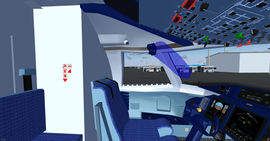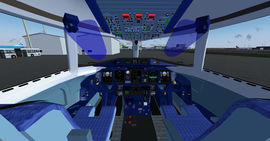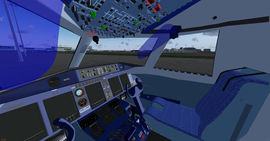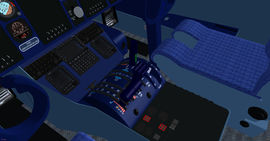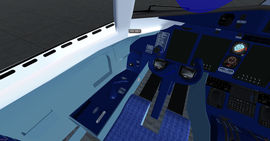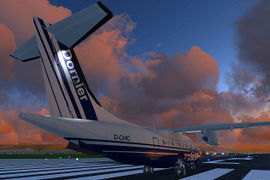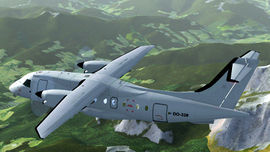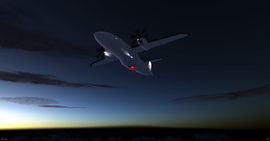Dornier 328
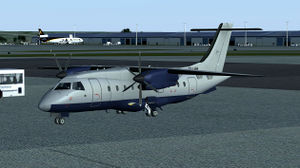 | |
| Type | Airliner |
|---|---|
| Author(s) |
|
| FDM | JSBSim |
| --aircraft= | do328-110 |
| Status | Early production |
| FDM |
|
| Systems |
|
| Cockpit |
|
| Model |
|
| Download |
|
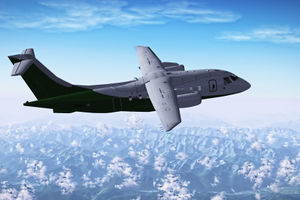 | |
| Type | Airliner |
|---|---|
| Author(s) |
|
| FDM | JSBSim |
| --aircraft= | do328-300 |
| Status | Early production |
| FDM |
|
| Systems |
|
| Cockpit |
|
| Model |
|
The Dornier 328 aircraft is a shortrange commuter, developed and built by Dornier. It was the last flying aircraft made by Dornier, and the last airliner completely developed and built in Germany.
The FlightGear model is currently in development, simulating the Dornier 328-110 Turboprop with ground spoilers and the Dornier 328-300 Jet. It features a realistic fdm, detailed PFD, MFD and EICAS displays with many subpages, a realistic electrical systems and has an incredible good framerate. A very detailed cockpit is in progress and will feature ALS shadows and lightmaps. It will have the same good quality like the EC135 P2 and Cessna 182 S, with comparable good framerate!
Special Thanks to the user Groucho from the FlightGear forums, who made it possible for me look into the flight manual! Also special thanks to xcvb85 who is programming the systems and is responsible for the great Canvas displays and systems!
NOTAM
- # Please regard FlightGear's etiquette: contact the authors first you help and contribute - this helps to prevent chaos in developing, since the efforts can be coordinated.
History
The development has been started back in the 1980s as successor for the Dornier 228. Dornier found that there was a market for a 33-passenger aircraft, so they created an aircraft with a complete round fuselage and the TNT-wing (Tragflügel neuer Technologie = Wing of New Technology) of the Dornier 228.
Development started December 1988; its maiden flight was on December 6, 1991 and in October 1993 was certified.
The aircraft had been developed for high climb rate and high speed, but short landing which was possible due the wing and the new developed propeller. As non-typical for this class of aircraft the flight deck has been fitted with 5 Displays from the Honeywell Primus 2000 avionic. The cabin was very comfortable for its class, as it was wide and round, and there was an active electronic noise suppression, giving a jet-like feeling.
In the 90s turboprop aircraft were unpopular, as flight companies preferred smaller jets. So Fairchild-Dornier developed the Dornier 328 JET, a jet driven version of the Dornier 328. There had been larger versions of this aircraft planned: Dornier 428 and 528, stretched versions of the Dornier 328, but these were never built.
When Fairchild-Dornier went bankrupt, the production of the Dornier 328 had been stopped in 2005, only 217 aircraft (prop and jet version) had been built, plus 3 prototypes.
Variants in real life
There are 4 Turboprop- variants available, and 3 Jet variants:
- Dornier 328-100 (basic version, 33 passengers, Pratt & Whitney Canada PW119)
- Dornier 328-110 (increased MTOW by 350kg, increased range), Pratt & Whitney Canada PW119B)
- Dornier 328-120 (special short range equipment)
- Dornier 328-130 (higher speed, improved rudder, Pratt & Whitney Canada PW119C)
Ground spoilers and APU were optional on all turboprop variants
- Dornier 328-300/-310/ 328JET (jet driven version)
- Dornier 328 Envoy 3 (Business Jet version)
- Dornier 328DBJ (Replacement of the Envoy 3 with a larger cabin)
Development notes
Features
FDM
- Realistic JSBSim fdm, matching AoA, Climbrates and V speeds based on following Data:
[1] [2] [3] [4] [5] [6] [7] [8] [9] [10] [11] [12]
Systems
- Complex EFIS with many EICAS pages (but still not finished)
- Complex RMU with many features (but still not finished)
- Electrical System: Complex system which also simulates currents and bus ties
- Pressurization System: Nothing special
328-1XX (Prop)
- accurate 3d-model based on original drawings with many details like static discharge antennas, animation of each prop blade, latest shaders with dynamic reflections, rain and lightmaps (landinglight, logolight, winglight, beacon)
- correct size of tires (different to Jet version)
- correct animation of groundspoiler
- Ice shield on fuselage modelled
- realistic wing flex
- Flightdeck progress- PFD and MFD working; working throttle quadrant, autoflight panel in progress
- paintkit for Inkscape
- 3 different realistic liveries and one blank livery
328-3XX (Jet)
- accurate 3d-model based on original drawings with many details like static discharge antennas, latest shaders with dynamic reflections, rain and lightmaps (landinglight, logolight, winglight, beacon)
- correct size of tires (different to Prop version)
- realistic wing flex
- paintkit for Inkscape
- 2 different liveries
To-do list
Near term tasks
FDM
- 328-1xx Prop: Fine Tuning engine and prop files for fuel and take off distance so it will match the published datas from FM.
- Correct groundspoiler logic (missing dependency on condition lever, different logic on jet version)
- Simulating roll spoiler (starts at aileron deflection > 4°)
- Simulating latch of throttle
Finishing the flightdeck
- Working autoflight panel
- Overhead Panel with fully 3d models knobs, switches, warning lights
- Center Pedestal
- Adding small details (pencils, placards...)
Systems
- Autoflight: More tuning, implement armed mode, add remaining operation modes
- Electrical System: Find out which devices are connected to which bus
- Fuel system: Pumps and valves missing
- Bleed air: Not even started
- Anti ice: Also missing
3D-model
- Optimize for Rembrandt (No-shadow tags, lights)
- Realistic sounds
Dornier 328-300/JET
- Modifiying the flightdeck to jet version (Overhead panel, center pedestal, Primus 2000 EICAS)
Mid term tasks
- Add cabin
Long term tasks
All that is left
References
|
| ||||||||
